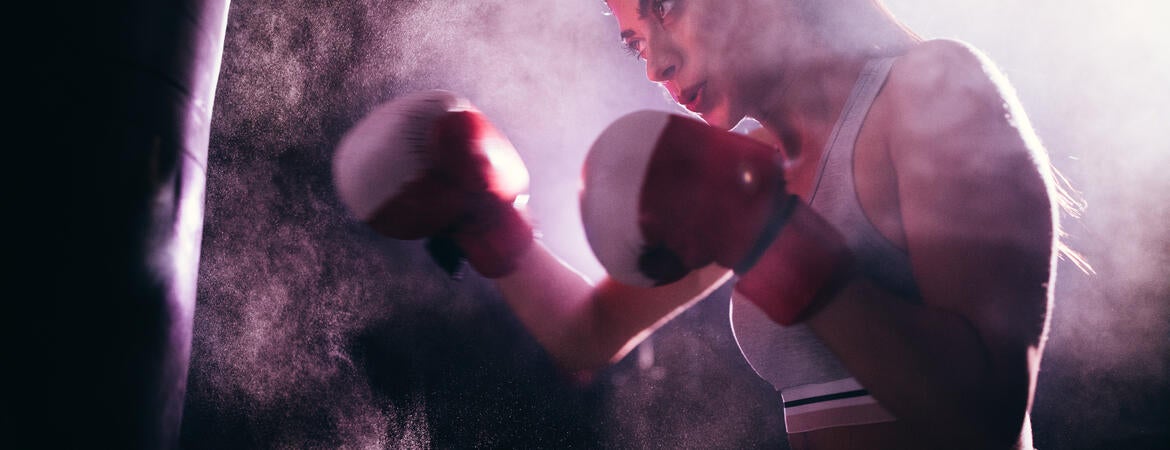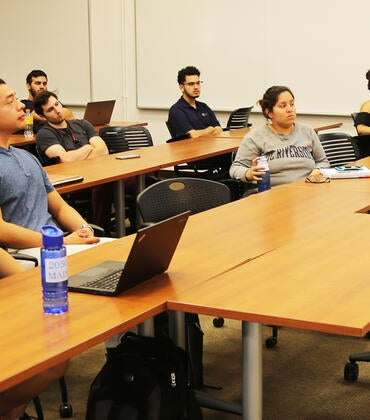
Women’s empowerment — when it comes to Women’s Mixed Martial Arts, or WMMA — is complex.
According to a UC Riverside study published in Gender & Society, women’s participation in the male-dominated sport of MMA has often been framed as a source of empowerment. For many women fighters, however, their experiences in WMMA are far from empowering.
The study, led by Justen Hamilton, a UCR doctoral candidate in sociology, found that although WMMA is promoted as challenging male dominance, as a sociologist, he’s noticed discrepancies between the way the sport is promoted and what he observed.
For more than a decade, Hamilton has been an MMA student, competitor, and coach. He also has a black belt in Brazilian Jiu-Jitsu.
“Many women fighters are not feminists,” Hamilton said. “The picture painted by MMA organizations was not my experience within the sport. Seeing how different this was presented in marketing campaigns, versus what my experience was, piqued my interest.”
“WMMA was being looked at with rose-colored lenses. The ideologies that govern the space are very much antifeminist. Throughout the project I was asking, ‘Is this an empowering space for women?’ and I’ve very much come to the conclusion that it is not.”
This study draws from more than four years of research on WMMA, an analysis of MMA media, and 40 in-person interviews with professional WMMA athletes. The interviews covered the athletes’ conceptions of empowerment, their beliefs about masculinity and femininity, their experiences in gendered harassment, and their relationships with intimate partners.
Hamilton found that for these female athletes, their adherence to neoliberal and postfeminist logics leads to a focus on individual achievement and personal responsibility and undermines their ability to serve as agents of feminist social change.
“Instead of seeing their participation as a communal achievement, they view it as an individual achievement. They believe that they can participate because they are exceptional,” Hamilton said. “This is tied to neoliberal ideology. And it hinders their ability to do things like unionize and negotiate for more equitable pay — unlike say, women’s soccer where they came together to demand more money.”
It wasn’t until 2013 that women were allowed to join organizations such as the Ultimate Fighting Championship, or UFC. For majority of women MMA fighters, their jobs are precarious, and result in mediocre earnings over time. While a fighter may make anywhere from $10,000 to $50,000 per fight, these athletes only fight, on average, two or three times a year, and can have their contracts terminated at any time, Hamilton said. For women outside of the UFC, they may even earn as little as a few thousand dollars per year.
Being professional fighters and showcasing their strength does not directly translate into overcoming issues that historically affect women, such as domestic violence or unequal pay, Hamilton said.
“Women as a group are not experiencing benefits from women’s participation in mixed martial arts,” said Hamilton, who in 2020 published another study highlighting how gender insecurity led women MMA athletes to date hypermasculine men.
To help explain the postfeminist sensibilities of the fighters in his study, Hamilton quotes some of the participants, including a 28-year-old woman named Kate. Being feminist is not part of her persona, she said.
“I don’t like feminists—the feminist agenda,” said Kate in the interview. “I don’t have to march and get crazy; I just do. I’ve never not been able to do whatever I wanted to do because of my gender, besides serving in an infantry role because at the time women weren’t allowed to… that’s not what I wanted to do anyway. I’m more of an empowerment type. And that goes for both genders. Do whatever you want. It’s super easy.”
Personal beliefs and individualistic sentiments blur what Hamilton calls “the very real inequities that exist between and within genders, as well as between and within races, classes, and other social groups.”
Hamilton’s study also demonstrates the potentially unique ways that women MMA fighters “do” gender, meaning how when promoting themselves, women MMA athletes try to emphasize the paradoxical nature of their status as women fighters, which in effect nullifies any challenges to the discursive relationship between masculinity and power. He terms this strategy, “doing both.”
“This duality was also central to the way in which many athletes in this study chose to market themselves — particularly those who occupied the privileged position of white, heterosexual, and conventionally attractive — as their woman-athlete subjectivities were commodified into brand identities that highlighted the paradoxical nature of these dual subjectivities,” Hamilton wrote in his study. “These brand identities often consisted of nicknames such as ‘Sex and Violence’ or ‘Pretty Badass,’ and strategically positioned these women to capitalize on the perceived incongruity of their dual status as combat sports athletes and hetero-feminine women.”
Another study participant, Scarlett, 32, said she markets herself as a “lover and a fighter.”
“I used to do modeling for a while and so I think that actually helped a lot with my entire career as an amateur because there wasn’t a lot of girly girls, then,” Scarlett said. “It was very, very slim. And I think that helped a lot ‘cause people were like, ‘Oh, wow! She’s really girly, she does modeling, and she can fight.’”




